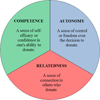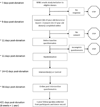Applying self-determination theory to the blood donation context: The blood donor competence, autonomy, and relatedness enhancement (Blood Donor CARE) trial
- PMID: 27979752
- PMCID: PMC5274558
- DOI: 10.1016/j.cct.2016.12.010
Applying self-determination theory to the blood donation context: The blood donor competence, autonomy, and relatedness enhancement (Blood Donor CARE) trial
Abstract
The Blood Donor Competency, Autonomy, and Relatedness Enhancement (Blood Donor CARE) project was designed as a practical application of self-determination theory to encourage retention of first-time donors. Self-determination theory proposes that people are more likely to persist with behaviors that are internally-motivated, and that externally-motivated behavior can evolve and become internalized given the appropriate socio-environmental conditions. According to self-determination theory, motivation to engage in blood donation may become increasingly self-determined if the behavior satisfies fundamental human needs for competence (a sense of self-efficacy to achieve specific goals), autonomy (a sense of volitional control over one's behavior), and relatedness (a sense of connection to a larger group). The primary aim of this randomized controlled trial is to examine the effect of competence, autonomy, and/or relatedness interventions on donor retention. Using a full factorial design, first-time donors will be assigned to a control condition or one of seven intervention conditions. Donation competence, autonomy, and relatedness, along with additional constructs associated with return donation, will be assessed before and after the intervention using online surveys, and donation attempts will be tracked for one-year using blood center donor databases. We hypothesize that, compared to the control condition, the interventions will increase the likelihood of a subsequent donation attempt. We will also examine intervention-specific increases in competence, autonomy, and relatedness as potential mediators of enhanced donor retention. By promoting first-time donor competence, autonomy, and relatedness our goal is to enhance internal motivation for giving and in so doing increase the likelihood of future donation.
Trial registration: ClinicalTrials.gov NCT02717338.
Keywords: Blood donation; Clinical trial; Internal motivational.
Copyright © 2016 Elsevier Inc. All rights reserved.
Conflict of interest statement
CRF, JLF, BWC, VF, LD, DAK, MR, and BHS have read and approved the final manuscript and certify that they have no conflicts of interest to report.
Figures



Similar articles
-
Results from the blood donor competence, autonomy, and relatedness enhancement (blood donor CARE) randomized trial.Transfusion. 2021 Sep;61(9):2637-2649. doi: 10.1111/trf.16577. Epub 2021 Jul 5. Transfusion. 2021. PMID: 34224590 Free PMC article. Clinical Trial.
-
An automated motivational interview promotes donation intention and self-efficacy among experienced whole blood donors.Transfusion. 2019 Sep;59(9):2876-2884. doi: 10.1111/trf.15402. Epub 2019 Jun 14. Transfusion. 2019. PMID: 31198990 Clinical Trial.
-
Motivating first-time, group O blood donors to return: Rationale and design of a randomized controlled trial of a post-donation telephone interview.Contemp Clin Trials. 2015 Sep;44:64-69. doi: 10.1016/j.cct.2015.07.020. Epub 2015 Aug 3. Contemp Clin Trials. 2015. PMID: 26247570 Free PMC article.
-
The psychology of blood donation: current research and future directions.Transfus Med Rev. 2008 Jul;22(3):215-33. doi: 10.1016/j.tmrv.2008.02.005. Transfus Med Rev. 2008. PMID: 18572097 Review.
-
A meta-analysis of techniques to promote motivation for health behaviour change from a self-determination theory perspective.Health Psychol Rev. 2019 Mar;13(1):110-130. doi: 10.1080/17437199.2018.1534071. Epub 2018 Oct 16. Health Psychol Rev. 2019. PMID: 30295176
Cited by
-
The influence of service quality and anticipated emotions on donor loyalty: an empirical analysis in blood centres in Spain.Health Care Manag Sci. 2022 Dec;25(4):623-648. doi: 10.1007/s10729-022-09600-9. Epub 2022 Jul 16. Health Care Manag Sci. 2022. PMID: 35841450 Free PMC article.
-
A motivational interview promotes retention of blood donors with high internal motivation.Transfusion. 2017 Oct;57(10):2433-2439. doi: 10.1111/trf.14203. Epub 2017 Jul 3. Transfusion. 2017. PMID: 28671277 Free PMC article.
-
What would it take to convince you to donate? A survey study of the relationship between motivators, barriers, and payment for whole blood, plasma, and platelet donation.Transfusion. 2022 Jun;62(6):1251-1260. doi: 10.1111/trf.16886. Epub 2022 Apr 25. Transfusion. 2022. PMID: 35467768 Free PMC article.
-
The Development of a Social Networking-Based Relatedness Intervention Among Young, First-Time Blood Donors: Pilot Study.JMIR Public Health Surveill. 2018 Apr 26;4(2):e44. doi: 10.2196/publichealth.8972. JMIR Public Health Surveill. 2018. PMID: 29699961 Free PMC article.
-
Blood donation motivators and barriers reported by young, first-time whole blood donors: Examining the association of reported motivators and barriers with subsequent donation behavior and potential sex, race, and ethnic group differences.Transfusion. 2022 Dec;62(12):2539-2554. doi: 10.1111/trf.17162. Epub 2022 Oct 24. Transfusion. 2022. PMID: 36281204 Free PMC article.
References
-
- Whitaker B, Rajbhandary S, Kleinman S, Harris A, Kamani N. Trends in United States blood collection and transfusion: results from the 2013 AABB Blood Collection, Utilization, and Patient Blood Management Survey. Transfusion. 2016 - PubMed
-
- Callero PL, Howard JA, Piliavin JA. Helping behavior as role behavior: Disclosing social structure and history in the analysis of prosocial action. Social Psychology Quarterly. 1987;50(3):247–256.
-
- Callero PL. Role-identity salience. Social Psychology Quarterly. 1985;48(3):203–215.
-
- Charng H, Piliavin J, Callero PL. Role identity and reasoned action in the prediction of repeated behavior. Social Psychology Quarterly. 1988;51(4):303–317.
-
- Piliavin JA, Callero PL. Giving Blood: The Development of an Altruistic Identity. Baltimore: Johns Hopkins; 1991.
Publication types
MeSH terms
Associated data
Grants and funding
LinkOut - more resources
Full Text Sources
Other Literature Sources
Medical

